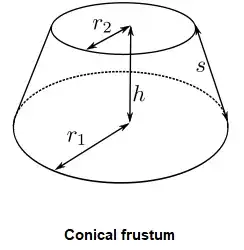I will be starting my question with an argument on surface area of a frustum.
Let center of smaller face (with radius $r_2$) be placed on the origin of $x$-$y$ coordinate system.
Then, $y = f(x) = mx +$ $r_2$, will be equal the radius function with respect to $x$. For approximation of surface area we can Partition the interval $[0,h]$ into n sub-intervals.
$P = \{x_0, x_1, ...., x_n\}$ where, $x_0$= $0$ and $x_n$ = $h$.
Now, Lower approximation ($L$) for surface area can be done as:
$$L = \sum_{k=1}^n 2\pi f(x_{k-1})\Delta x_k $$
and for Upper approximation ($U$):
$$U = \sum_{k=1}^n 2\pi f(x_{k})\Delta x_k $$
But, $ \lim \limits_{||P|| \to 0} $ (U) = $ \lim \limits_{||P|| \to 0} $ (L) = $\int_0^h 2 \pi f(x) \,dx$
Solving this integral will result in:
Surface Area $= \pi h (r_1 + r_2)$, which is not correct.
Can anyone tell me, what am I doing wrong?? Then I will be posting my question further for the generalized definition of surface area (based on frustums).
